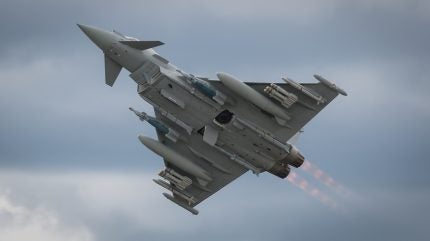
The UK is the only lead nation of the multinational Eurofighter programme not to have placed an order for additional aircraft in 2024, following the commitment to purchase 25 aircraft each by Spain and Italy late last year and Germany’s ongoing Quadriga acquisition.
A collaborative effort between Airbus, BAE Systems, Leonardo, and the partner nations of the UK, Germany, Spain, and Italy, the Eurofighter is intended to remain operational beyond 2060. Beginning development in 1989, the first of the Tranche 1 aircraft arrived in service among the core nations from 2003-2005.
However, while the UK’s European partners were busy concluding or progressing on the delivery of new aircraft in 2024, the UK’s own commitment to additional airframes appears uncertain.
The German Quadriga programme will see 30 single-seat and eight twin-seat latest generation Tranche 4 Eurofighters acquired to replace 38 older Tranche 1 aircraft, with the aircraft to be delivered between 2025-2030.
Spain’s Halcon programme will deliver 20 new Tranche 4 Eurofighters under Halcon I to the Spanish Air Force from 2026-2030. A follow up agreement for an additional 25 Eurofighters under Halcon II was formally concluded in December 2024.

The same month, Italy confirmed a contract for 24 Eurofighters to replace current in-service Tranche 1 aircraft, with the new variants offering upgrades in avionics, weaponry, and operational capabilities, and will be equipped to handle Brimstone III and Meteor missiles.

US Tariffs are shifting - will you react or anticipate?
Don’t let policy changes catch you off guard. Stay proactive with real-time data and expert analysis.
By GlobalDataThe UK is a full Tranche behind, only recently moving to integrate an active electronic scanning array radar (AESA) into its 40 Tranche 3 airframes. Unlike the other Eurofighter partners, the UK has not yet committed to replacing its oldest airframes, with the RAF due to lose its 30 Tranche 1 fighters in 2025, leaving just 107 Tranche 2 and Tranche 3 aircraft in service.
By comparison, the German Air Force operates around 140 Eurofighters and will likely commit to the programme throughout its life span given the level of industrial participation.
GlobalData analysis from 2024 indicates that Italy operates 95 Eurofighter multirole fighters, while Spain has a fleet of 70 aircraft.
New Eurofighter orders needed to sustain industry
In March 2024, Airbus stated that in order to maintain expertise and the capability to develop and produce fighters in Germany and bridge a potential decade-long production gap, an additional order of around 100 new Tranche 5 Eurofighters would be required.
Of these, 50 aircraft will be produced by Airbus in Manching, Germany, with the remaining 50, coming from potential export orders, to be assembled in Italy (Leonardo), Spain (Airbus), and the UK (BAE Systems).
In December 2024, Qatar reportedly came to the rescue of UK industry with the purchase of 12 additional Eurofighters for a fee of around £6bn ($7.4bn), a move that brought some much-needed certainty to BAE Systems’ share of the fighter programme. Qatar is a designated UK export country for the Eurofighter.
It is uncertain whether the UK will look to acquire anymore Eurofighters, with the RAF’s Tranche 1 fleet out of service this year and focus increasingly turning to the sixth-generation Tempest concept, part of the Global Combat Airforce Programme in collaboration with Italy and Japan.
UK Minister for Defence Procurement Maria Eagle sought to make light of the situation during a House of Commons question and answer session on 6 January, stating domestic and export orders were “very important” and that the government was “working hard” on unnamed export campaigns.
“The rest of the spend in such matters is part of the [Strategic Defence Review] and once that is completed there will be conclusions. Perhaps it will not be a Christmas present, but… a present at some time later on,” Eagle said.



